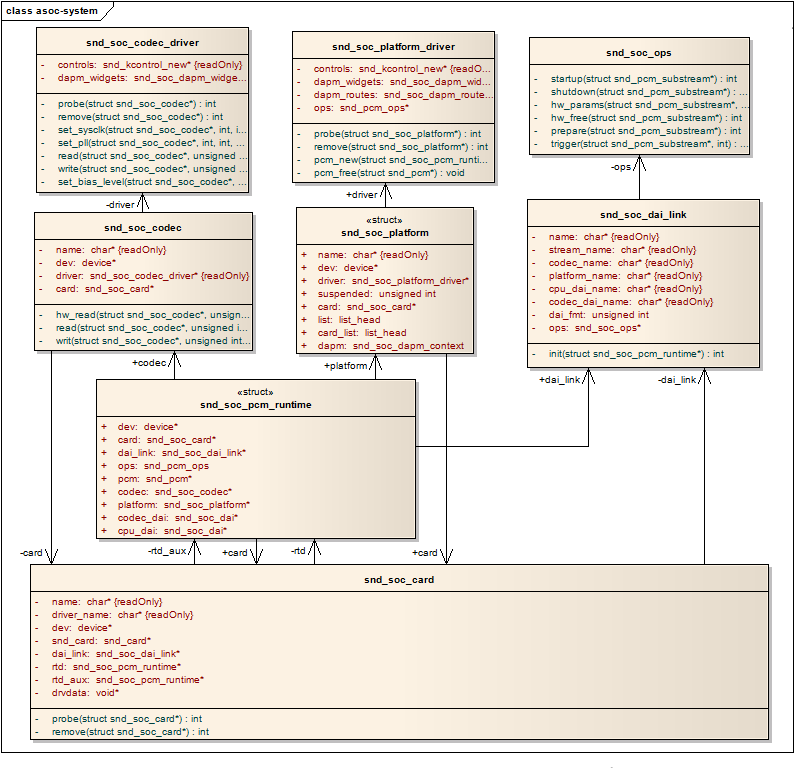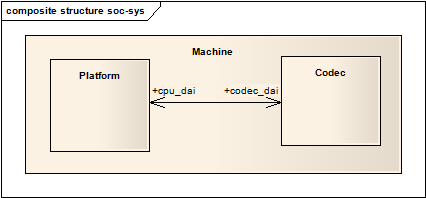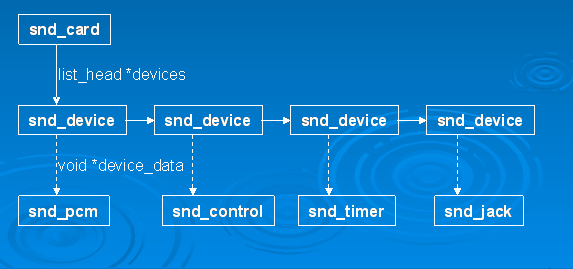在Linux系统中,ALSA音频驱动是一种非常重要的驱动程序。它负责管理音频设备并向用户空间提供接口。在上一篇文章中,我们已经深入探讨了ALSA音频驱动的实现原理和相关技术。在本文中,我们将继续探讨ALSA音频驱动的高级特性和应用场景。
在软件层面,ASoC也把嵌入式设备的音频系统同样分为3大部分,Machine,Platform和Codec。
Codec驱动 ASoC中的一个重要设计原则就是要求Codec驱动是平台无关的,它包含了一些音频的控件(Controls),音频接口,DAMP(动态音频电源管理)的定义和某些Codec IO功能。
为了保证硬件无关性,任何特定于平台和机器的代码都要移到Platform和Machine驱动中。所有的Codec驱动都要提供以下特性:
Codec DAI 和 PCM的配置信息;
Codec的IO控制方式(I2C,SPI等);
Mixer和其他的音频控件;
Codec的ALSA音频操作接口;
必要时,也可以提供以下功能:
DAPM描述信息;
DAPM事件处理程序;
DAC数字静音控制
Platform驱动 它包含了该SoC平台的音频DMA和音频接口的配置和控制(I2S,PCM,AC97等等);它也不能包含任何与板子或机器相关的代码。
Machine驱动 Machine驱动负责处理机器特有的一些控件和音频事件(例如,当播放音频时,需要先行打开一个放大器);单独的Platform和Codec驱动是不能工作的,它必须由Machine驱动把它们结合在一起才能完成整个设备的音频处理工作。
整个ASoC是由一些列数据结构组成,要搞清楚ASoC的工作机理,必须要理解这一系列数据结构之间的关系和作用,下面的关系图展示了ASoC中重要的数据结构之间的关联方式(我的内核是2.6.37版本 与2.6.35版本已经有区别了):
由上图我们可以看出,2.6.37中的数据结构更为合理和清晰,取消了snd_soc_device结构,直接用snd_soc_card取代了它,并且强化了snd_soc_pcm_runtime的作用,同时还增加了另外两个数据结构snd_soc_codec_driver和snd_soc_platform_driver,用于明确代表Codec驱动和Platform驱动。到这里可能会问pltform和codec是这么关联的?看下图:
通过下面的代码结构体的成员不难发现ASoC的各个成员(Platform, codec, dai)通过名字联系在一起:
static struct snd_soc_dai_link ti81xx_mcasp_dai[] = {
{
.name = "TVP5158AUDIO",
.stream_name = "TVP-PCM",
.cpu_dai_name= "davinci-mcasp.0",
.codec_dai_name = "tvp5158-hifi",
.platform_name ="davinci-pcm-audio",
.codec_name = "tvp5158-audio",
.ops = &ti81xx_dvr_ops,
},
{
.name = "TLV320AIC3X",
.stream_name = "AIC3X",
.cpu_dai_name= "davinci-mcasp.2",
.codec_dai_name = "tlv320aic3x-hifi",
.codec_name = "tlv320aic3x-codec.1-0018",
.platform_name = "davinci-pcm-audio",
.init = ti81xx_dvr_aic3x_init,
.ops = &ti81xx_dvr_ops,
}
};
#ifdef CONFIG_SND_SOC_TI81XX_HDMI
static struct snd_soc_dai_link ti81xx_hdmi_dai = {
.name = "HDMI_SOC_LINK",
.stream_name = "hdmi",
.cpu_dai_name = "hdmi-dai",
.platform_name = "davinci-pcm-audio",
.codec_dai_name = "HDMI-DAI-CODEC", /* DAI name */
.codec_name = "hdmi-dummy-codec",
};
#endif
static struct snd_soc_card ti81xx_dvr_snd_card0 = {
.name = "TI81XX SOUND0",
.dai_link = ti81xx_mcasp_dai,
.num_links = ARRAY_SIZE(ti81xx_mcasp_dai),
};
#ifdef CONFIG_SND_SOC_TI81XX_HDMI
static struct snd_soc_card ti81xx_dvr_snd_card1 = {
.name = "TI81XX SOUND1",
.dai_link = &ti81xx_hdmi_dai,
.num_links = 1,
};
#endif
从上面看两个snd_coc_card两个结构体通过平台设备私有数据的方式传递给平台驱动,并且通过snd_soc_register_card创建了两个声卡card0 card1。
我们已经知道了ALSA音频的软件架构分为Machine,Platform和Codec三个部分,从上面的代码可以清楚的看出:
Codec:声卡0对应的Codec是tvp5158和TLV320AIC3X;声卡1则对应的Codec是HDMI。
Platform:TI的davinci系列。
Machine:TI81xx。
这些部分怎么连接起来的?接下来我们要分析ALSA架构中一个非常重要的函数snd_soc_instantiate_card,先贴下整个代码:
static void snd_soc_instantiate_card(struct snd_soc_card *card)
{
struct platform_device *pdev = to_platform_device(card->dev);
int ret, i;
mutex_lock(&card->mutex);
if (card->instantiated) {
mutex_unlock(&card->mutex);
return;
}
/* bind DAIs */
for (i = 0; i num_links; i++)
soc_bind_dai_link(card, i);
/* bind completed ? */
if (card->num_rtd != card->num_links) {
mutex_unlock(&card->mutex);
return;
}
/* card bind complete so register a sound card */
ret = snd_card_create(SNDRV_DEFAULT_IDX1, SNDRV_DEFAULT_STR1,
card->owner, 0, &card->snd_card);
if (ret "asoc: can't create sound card for card %s\n",
card->name);
mutex_unlock(&card->mutex);
return;
}
card->snd_card->dev = card->dev;
#ifdef CONFIG_PM
/* deferred resume work */
INIT_WORK(&card->deferred_resume_work, soc_resume_deferred);
#endif
/* initialise the sound card only once */
if (card->probe) {
ret = card->probe(pdev);
if (ret for (i = 0; i num_links; i++) {
ret = soc_probe_dai_link(card, i);
if (ret "asoc: failed to instantiate card %s: %d\n",
card->name, ret);
goto probe_dai_err;
}
}
snprintf(card->snd_card->shortname, sizeof(card->snd_card->shortname),
"%s", card->name);
snprintf(card->snd_card->longname, sizeof(card->snd_card->longname),
"%s", card->name);
ret = snd_card_register(card->snd_card);
if (ret "asoc: failed to register soundcard for %s\n", card->name);
goto probe_dai_err;
}
#ifdef CONFIG_SND_SOC_AC97_BUS
/* register any AC97 codecs */
for (i = 0; i num_rtd; i++) {
ret = soc_register_ac97_dai_link(&card->rtd[i]);
if (ret "asoc: failed to register AC97 %s\n", card->name);
while (--i >= 0)
soc_unregister_ac97_dai_link(&card->rtd[i]);
goto probe_dai_err;
}
}
#endif
card->instantiated = 1;
mutex_unlock(&card->mutex);
return;
probe_dai_err:
for (i = 0; i num_links; i++)
soc_remove_dai_link(card, i);
card_probe_error:
if (card->remove)
card->remove(pdev);
snd_card_free(card->snd_card);
mutex_unlock(&card->mutex);
}
从上面的标记为红色的代码则是这个函数中要重点分析的部分:
1.card->instantiated 来判断该卡是否已经实例化,如果已经实例化则直接返回。
2.card->num_links cpucode DAI链接数,声卡0为2个link(snd_soc_dai_link), 声卡1为1个link(snd_soc_dai_link);在soc_probe的时候从platform_device参数中取出num_links。
3.soc_bind_dai_link ASoC定义了三个全局的链表头变量:codec_list、dai_list、platform_list,系统中所有的Codec、DAI、Platform都在注册时连接到这三个全局链表上。
soc_bind_dai_link函数逐个扫描这三个链表,根据card->dai_link[]中的名称进行匹配,匹配后把相应的codec,dai和platform实例赋值到card->rtd[]中(snd_soc_pcm_runtime)。
经过这个过程后,snd_soc_pcm_runtime:(card->rtd)中保存了本Machine中使用的Codec,DAI和Platform驱动的信息。
那么,这个链表的元素从哪里来的呢?这些元素的名字则是由设备的名字(device->name)和对应的驱动的名字(device->driver->name)组成。
dai是通过snd_soc_register_dai函数添加到dai_list链表中(davinci-hdmi.c(“hdmi-dai”), davinci-mcasp.c(“davinci-mcasp.0”, “davinci-mcasp.1”, 注意平台设备的时候,如果id不等于-1的时候,设备的名字有name和id组成 (platform_device_add))),rtd->cpu_dai = cpu_dai;//填充snd_soc_pcm_runtime结构体中的cpu_dai。
codec是通过snd_soc_register_codec函数添加到codec_list链表中(tvp5158-audio.c(“tvp5158-audio”), ti81xx_hdmi.c(“hdmi-dummy-codec”), tlv320aic3x.c(“tlv320aic3x-codec.1-0018” 注意i2c子系统中的client设备的名字由I2C适配器的ID和client的地址组成1-0018(i2c_new_device)))
rtd->codec = codec;//填充snd_soc_pcm_runtime结构体中的codec
rtd->codec_dai = codec_dai;//填充snd_soc_pcm_runtime结构体中的codec_dai
platform是通过snd_soc_register_platform函数添加到platform_list(davinci-pcm.c(“”davinci-pcm-audio””))
rtd->platform = platform;//填充snd_soc_pcm_runtime结构体中的platform
4.snd_card_create 创建一个声卡的实例,其代码如下:
/**
* snd_card_create - create and initialize a soundcard structure
* @idx: card index (address) [0 ... (SNDRV_CARDS-1)]
* @xid: card identification (ASCII string)
* @module: top level module for locking
* @extra_size: allocate this extra size after the main soundcard structure
* @card_ret: the pointer to store the created card instance
*
* Creates and initializes a soundcard structure.
*
* The function allocates snd_card instance via kzalloc with the given
* space for the driver to use freely. The allocated struct is stored
* in the given card_ret pointer.
*
* Returns zero if successful or a negative error code.
*/
int snd_card_create(int idx, const char *xid,
struct module *module, int extra_size,
struct snd_card **card_ret)
{
struct snd_card *card;
int err, idx2;
if (snd_BUG_ON(!card_ret))
return -EINVAL;
*card_ret = NULL;
if (extra_size if (!card)
return -ENOMEM;
if (xid)
strlcpy(card->id, xid, sizeof(card->id));
err = 0;
mutex_lock(&snd_card_mutex);
if (idx for (idx2 = 0; idx2 if (~snd_cards_lock & idx & 1if (module_slot_match(module, idx2)) {
idx = idx2;
break;
}
}
}
if (idx for (idx2 = 0; idx2 if (~snd_cards_lock & idx & 1if (!slots[idx2] || !*slots[idx2]) {
idx = idx2;
break;
}
}
}
if (idx else if (idx if (snd_cards_lock & (1 else if (idx >= SNDRV_CARDS)
err = -ENODEV;
if (err "cannot find the slot for index %d (range 0-%i), error: %d\n",
idx, snd_ecards_limit - 1, err);
goto __error;
}
snd_cards_lock |= 1 if (idx >= snd_ecards_limit)
snd_ecards_limit = idx + 1; /* increase the limit */
mutex_unlock(&snd_card_mutex);
card->number = idx;
card->module = module;
INIT_LIST_HEAD(&card->devices);
init_rwsem(&card->controls_rwsem);
rwlock_init(&card->ctl_files_rwlock);
INIT_LIST_HEAD(&card->controls);
INIT_LIST_HEAD(&card->ctl_files);
spin_lock_init(&card->files_lock);
INIT_LIST_HEAD(&card->files_list);
init_waitqueue_head(&card->shutdown_sleep);
#ifdef CONFIG_PM
mutex_init(&card->power_lock);
init_waitqueue_head(&card->power_sleep);
#endif
/* the control interface cannot be accessed from the user space until */
/* snd_cards_bitmask and snd_cards are set with snd_card_register */
err = snd_ctl_create(card);
if (err "unable to register control minors\n");
goto __error;
}
err = snd_info_card_create(card);
if (err "unable to create card info\n");
goto __error_ctl;
}
if (extra_size > 0)
card->private_data = (char *)card + sizeof(struct snd_card);
*card_ret = card;
return 0;
__error_ctl:
snd_device_free_all(card, SNDRV_DEV_CMD_PRE);
__error:
kfree(card);
return err;
}
通过红色标记的代码发现,这个函数主要做的初始化声卡的一些设备链表devices,读写信号量(rw_semaphore)读写锁(rwlock),锁(spinlock_t),链表,等待队列(wait_queue_head_t);调用snd_ctl_create函数初始化snd_device_ops并且添加声卡控制的逻辑设备(SNDRV_DEV_CONTROL)到声卡的设备链表card->devices中;snd_info_card_create函数创建是声卡proc的入口;最后是声卡的私有数据。
5.soc_probe_dai_link cpu_dai,codec,platform,codec_dai顺序执行其驱动的probe函数并且添加的声卡下code_dev_list,platform_dev_list,dai_dev_list中;
并且每个dail_link(这个定义在平台设备(machine))创建一个设备,并且创建sys文件接口,即/sys/devices/platform/soc-aduio.0目录下创建两个目录TLV320AIC3X,TVP5158AUDIO和soc-aduio.1目录下创建目录HDMI_SOC_LINK,并且在这三个目录下创建codec_reg,dapm_widget,pmdown_time三个sys文件接口rtd->dev.parent = card->dev; //其父设备card-dev
(snd_pcm)pcm组件的创建:首先调用snd_pcm_new函数初始化snd_device_ops,创建回放(SNDRV_PCM_STREAM_PLAYBACK)和采集(SNDRV_PCM_STREAM_CAPTURE)子流,调用snd_device_new将逻辑PCM设备添加到声卡的设备链表card->devices中;
然后初始化全局变量soc_pcm_ops,将声卡的逻辑平台设备(”davinci-pcm-audio”)驱动的一些操作函数赋值给soc_pcm_ops,这个结构体主要系统调用时候用到;
最后是调用逻辑平台设备(”davinci-pcm-audio”)驱动的pcm_new函数去申请DMA。
6.snd_card_register 首先在/sys/class/sound目录下创建card0,card1两个目录;
然后通过snd_device_register_all->snd_device_ops->dev_register将声卡下面的逻辑设备全部注册到snd_minors[]数组(这个数组很重要,所有的声卡相关系统调用都是它),当调用到pcm->dev_register函数时候,次函数调用**snd_pcm_timer_init()**注册snd_minors[]数组中,添加到声卡的逻辑设备链表中;当系统调用的时候在open的时候,会从snd_minors[]数组获取
接着在/proc/asound/下创建card0,card1, 并且创建SOUND0,SOUND1分别软连接card0,card1(proc_symlink软连接函数);
最后在card0,card1目录下创建id,number两个文件。
直此,声卡在底层初始化的分析已经结束,下一篇将分析声卡的系统调用过程。
总之,ALSA音频驱动是Linux系统中不可或缺的一部分。它负责管理音频设备并向用户空间提供接口。希望本文能够帮助读者更好地理解ALSA音频驱动的高级特性和应用场景。
以上就是良许教程网为各位朋友分享的Linu系统相关内容。想要了解更多Linux相关知识记得关注公众号“良许Linux”,或扫描下方二维码进行关注,更多干货等着你 !






 微信扫一扫打赏
微信扫一扫打赏
 支付宝扫一扫打赏
支付宝扫一扫打赏

.png)
